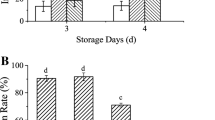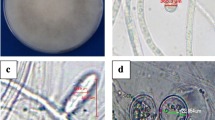Abstract
Volatiles released from the spent mushroom substrate (SMS) of shiitake mushrooms (Lentinula edodes) are known to be effective for suppressing the Alternaria sooty spot disease of cabbage that is caused by Alternaria brassicicola. We analyzed a volatile compound released from shiitake SMS by gas chromatography–mass spectrometry and identified octan-3-one as a major volatile compound. Octan-3-one exerted an antimicrobial activity on a wide range of fungal and bacterial plant pathogens, and it inhibited Alternaria sooty spot of cabbage and gray mold of tomato. Octan-3-one was observed to be a fungistatic compound as after its removal, spores of A. brassicicola initiated germination. Octan-3-one is already known as an important flavor compound in mushrooms and is considered to have relatively low toxicity; our findings indicate that it may thus be useful for protecting crops from fungal and bacterial diseases in closed spaces such as greenhouses, crop storage rooms, and shipping containers.





Similar content being viewed by others
Data availability
The datasets generated during and/or analysed during the current study are available from the corresponding author on reasonable request.
References
Aktar MW, Sengupta D, Chowdhury A (2009) Impact of pesticides use in agriculture: their benefits and hazards. Interdiscip Toxicol 2:1–12
Allen PJ (1955) The role of a self-inhibitor in the germination of rust uredospores. Phytopathology 215:259–266
Arase S, Kondo Y, Parada RY, Otani H, Ueno M, Kihara J (2013) Suppression of rice blast disease by autoclaved water extract from the spent mushroom substrate of Lyophyllum decastes. Mushroom Sci Biotech 21:79–83
Barrios-Gonzáles J, Martinez C, Aguilera A, Raimbault M (1989) Germination of concentrated suspensions of spores from Aspergillus niger. Biotechnol Lett 11:551–554
Beltran-Garcia MJ, Estarron-Espinosa M, Ogura T (1997) Volatile compounds secreted by the oyster mushroom (Pleurotus ostreatus) and their antibacterial activities. J Agric Food Chem 45:4049–4052
Chang ST, Miles PG (eds) (2004) Mushrooms: cultivation, nutritional value, medicinal effect, and environmental impact. CRC Press, Boca Raton, USA
Chen CC, Wu CM (1984) Studies on the enzymic reduction of 1-octen-3-one in mushroom Agaricus bisporus. J Agric Food Chem 32:1342–1344
Chitarra GS, Abee T, Rombouts FM, Posthumus MA, Dijksterhuis J (2004) Germination of Penicillium paneum conidia is regulated by 1-octen-3-ol, a volatile self-inhibitor. Appl Environ Microbiol 70:2823–2829
Chitarra GS, Abee T, Rombouts FM, Dijksterhuis J (2005) 1-Octen-3-ol inhibits conidia germination of Penicillium paneum despite of mild effects on membrane permeability respiration, intracellular pH, and changes the protein composition. FEMS Microbiol Ecol 54:67–75
Combet E, Henderson J, Eastwood DC, Burton KS (2006) Eight-carbon volatiles in mushrooms and fungi: properties, analysis, and biosynthesis. Mycoscience 47:317–326
Combet E, Henderson J, Eastwood DC, Burton KS (2009) Influence of sporophore development, damage, storage, and tissue specificity on the enzymic formation of volatiles in mushrooms (Agaricus bisporus). J Agric Food Chem 57:3709–3717
Cronin DA, Word MK, Word MK (1971) The characterization of some mushroom volatiles. J Sci Food Agric 22:477–479
Dayan FE, Cantrell CL, Duke SO (2009) Natural products in crop protection. Bioorgan Med Chem 17:4022–4034
Engelmeier D, Hadacek F (2006) Antifungal natural products: assays and applications. In: Rai M, Carpinella MC (eds) Advances in phytomedicine series vol. 3: natural occurring bioactive compounds. Elsevier, Amsterdam, the Netherlands, pp 417–463
Fujita R, Yokono M, Ube N, Okuda Y, Ushijima S, Fukushima-Sakuno E, Ueno K, Osaki-Oka K, Ishihara A (2021) Suppression of Alternaria brassicicola infection by volatile compounds from spent mushroom substrates. J Biosci Bioeng 132:25–32
Gottlieb D (1997) Endogenous inhibitors of spore germination. Phytopathology 63:1326–1327
Hamamoto E, Kimura N, Nishino S, Ishihara A, Otani H, Osaki-Oka K (2021) Antimicrobial activity of the volatile compound 3,5-dichloro-4-methoxybenzaldehyde, produced by the mushroom Porostereum spadiceum against plant-pathogenic bacteria and fungi. J Appl Microbiol 131:1431–1439
Inagaki H, Yamaguchi A (2009) Spent substrate of shiitake (Lentinula edodes) inhibits symptoms of anthracnose in cucumber. Mushroom Sci Biotech 17:113–115
Ishihara A, Goto N, Kikkawa M, Ueno M, Ushijima S, Ube N, Ueno K, Osaki-Oka K (2018) Identification of antifungal compounds in spent mushroom substrate of Lentinula edodes. J Pestic Sci 43:108–113
Ishihara A, Ando K, Yoshioka A, Murata K, Kokubo Y, Morimoto N, Ube N, Yabuta Y, Ueno K, Osaki-Oka K (2019) Induction of defense responses by extracts of spent mushroom substrates in rice. J Pestic Sci 44:89–96
Ishii H (2006) Impact of fungicide resistance in plant pathogens on crop disease control and agricultural environment. Jpn Agric Res Q 40:205–211
Kaminski E, Stawicki S, Wasowicz E (1974) Volatile flavor compounds produced by molds of Aspergillus, Penicillium, and Fungi imperfecti. Appl Microbiol 27:1001–1004
Kim BS, Hwang BK (2007) Microbial fungicides in the control of plant diseases. J Phytopathol 155:641–653
Koitabashi M, Kajitani Y, Hirashima K (2004) Antifungal substances produced by fungal strain Kyu-W63 from wheat leaf and its taxonomic position. J Gen Plant Pathol 70:124–130
Lee SO, Kim HY, Choi GJ, Lee HB, Jang KS, Choi YH, Kim JG (2009) Mycofumigation with Oxyporus latemarginatus EF069 for control of postharvest apple decay and Rhizoctonia root rot on moth orchid. J Appl Microbiol 106:1213–1219
Mega JA (1981) Mushroom flavor. J Agric Food Chem 29:1–4
Nemčovič M, Jakubĭková L, Vĭden I, Farkaš V (2008) Induction of conidiation by endogenous volatile compounds in Trichoderma spp. FEMS Microbiol Lett 284:231–236
Nishimura A, Yoshioka A, Kariya K, Ube N, Ueno K, Tebatashi S, Osaki-Oka K, Ishihara A (2021) Sugar in an aqueous extract of the spent substrate of the mushroom Hypsizygus marmoreus induce defense responses in rice. Biosci Biotechnol Biochem 85:743–755
Nishino S, Parada RY, Ichiyanagi T, Maekawa N, Shimomura N, Otani H (2013) 1-Phenyl-3-pentanone, a volatile compound from the edible mushroom Mycoleptodonoides aitchisonii active against some phytopathogenic fungi. J Phytopathol 161:515–521
Oka K, Shimomura N, Maekawa N, Nakagiri A, Otani H (2014) Antifungal activity of 1-phenyl-3-pentanone produced by Mycoleptodonoides aitchisonii against plant-pathogenic fungi. Mushroom Sci Biotech 22:95–100
Oka K, Ishihara A, Sakaguchi N, Nishino S, Parada RY, Nakagiri A, Otani H (2015) Antifungal activity of volatile compounds produced by an edible mushroom Hypsizygus marmoteus against phytopathogenic fungi. J Phytopath 163:987–996
Okull DO, Beelman RB, Gourama H (2003) Antifungal activity of 10-oxo-trans-decenoic acid and 1-octen-3-ol against Penicillium expansum in potato dextrose agar medium. J Food Prot 66:1503–1505
Osaki-Oka K, Kodani T, Ishihara A (2018) Suppression of Alternaria sooty spot of cabbage by volatile compounds from spent substrates of shiitake (Lentinula edodes) and bunashimeji (Hypsizygus marmoreus) (in Japanese with English summary). Mushroom Sci Biotechnol 26:28–31
Osaki-Oka K, Suyama S, Sakuno E, Ushijima S, Nagasawa E, Maekawa N, Ishihara A (2019) Antifungal activity of the volatile compound isovelleral produced by ectomycorrhizal Russula fungi against plant-pathogenic fungi. J Gen Plant Pathol 85:428–435
Ouzouni PK, Koller WD, Badeka AV, Riganakos KA (2009) Volatile compounds from the fruiting bodies of three Hygrophorus mushrooms species from Northern Greece. Int J Food Sci Technol 44:854–859
Parada RY, Murakami S, Shimomura N, Otani H (2012) Suppression of fungal and bacterial diseases of cucumber plants by using the spent mushroom substrate of Lyophyllum decastes and Pleurotus eryngii. J Phytopathol 160:390–396
Petre CV, Dirtu AC, Niculaua M, Tanase C (2017) Volatile compounds in the aroma of three species of wood-rotting basidiomycetes and their antifungal potential. J Plant Develop 24:73–83
Pfeil RM, Mumma RO (1992) Air sampling of volatiles from Agaricus bisporus in a mushroom facility and from mushroom compost. HortScience 27:416–419
Pfeil RM, Mumma RO (1993) Bioassay for evaluating attraction of the phorid fly, Megaselia halterata to compost colonized by the commercial mushroom, Agaricus bisporus and to 1-octen-3-ol and 3-octanone. Entomol Exp Appl 69:137–144
Pinho PG, Ribeiro B, Gonçalves RF, Baptista P, Valentão P, Seabra RM, Andrade PB (2008) Correlation between the pattern volatiles and the overall aroma of wild edible mushrooms. J Agric Food Chem 56:1704–1712
Rinker DL (2017) Chapter 20: Spent mushroom substrate uses. In: Zied DC, Pardo-Giménez A (eds) Edible and medicinal mushrooms. Technology and applications. John Wiley & Sons Ltd., Hoboken, NJ, USA, pp 427–454
Sawahata T, Shimano S, Suzuki M (2008) Tricholoma matsutake 1-octen-3-ol and methyl cinnamate repel mycophagous Proisotoma minuta (Collembola: Insecta). Mycorrhiza 18:111–114
Schalchli H, Tortella GR, Rubilar O, Parra L, Hormazabal E, Quiroz A (2014) Fungal volatiles: an environmentally friendly tool to control pathogenic microorganisms in plants. Crit Rev Biotechnol 36:144–152
Strobel GA, Dirkse E, Sears J, Markworth C (2001) Volatile antimicrobials from Muscodor albus, a novel endophytic fungus. Microbiol 147:2943–2950
Yamanaka K (2017) Chapter 15: cultivation of mushrooms in plastic bottles and small bags, kindle edition. In: Zied DC, Pardo-Giménez A (eds) Edible and medicinal mushrooms. Technology and application. John Wiley & Sons Ltd., Hoboken, NJ, USA, pp 309–338
Acknowledgements
We express our sincere gratitude to Fukuda Farm (Tottori, Japan), JA Tottori Inaba Shiitake Mushroom Substrate Center (Tottori, Japan), and Minoru Industrial Co., Ltd. (Okayama, Japan) for providing SMS. This work was supported in part by grants from the JSPS KAKENHI (JP16K18657 and JP22K05652).
Author information
Authors and Affiliations
Corresponding author
Ethics declarations
Conflict of interest
The authors declare that they have no conflict of interest.
Ethical statement
This article does not contain any studies with human participants or animals performed by any of the authors.
Additional information
Publisher's Note
Springer Nature remains neutral with regard to jurisdictional claims in published maps and institutional affiliations.
Rights and permissions
Springer Nature or its licensor (e.g. a society or other partner) holds exclusive rights to this article under a publishing agreement with the author(s) or other rightsholder(s); author self-archiving of the accepted manuscript version of this article is solely governed by the terms of such publishing agreement and applicable law.
About this article
Cite this article
Muto, Y., Fukushima-Sakuno, E., Ishihara, A. et al. Antimicrobial activity of octan-3-one released from spent mushroom substrate of shiitake (Lentinula edodes) and its inhibitory effects on plant diseases. J Gen Plant Pathol 89, 122–131 (2023). https://doi.org/10.1007/s10327-022-01110-4
Received:
Accepted:
Published:
Issue Date:
DOI: https://doi.org/10.1007/s10327-022-01110-4




